sensor BMW 5 SERIES 2012 User Guide
[x] Cancel search | Manufacturer: BMW, Model Year: 2012, Model line: 5 SERIES, Model: BMW 5 SERIES 2012Pages: 335, PDF Size: 13.42 MB
Page 119 of 335
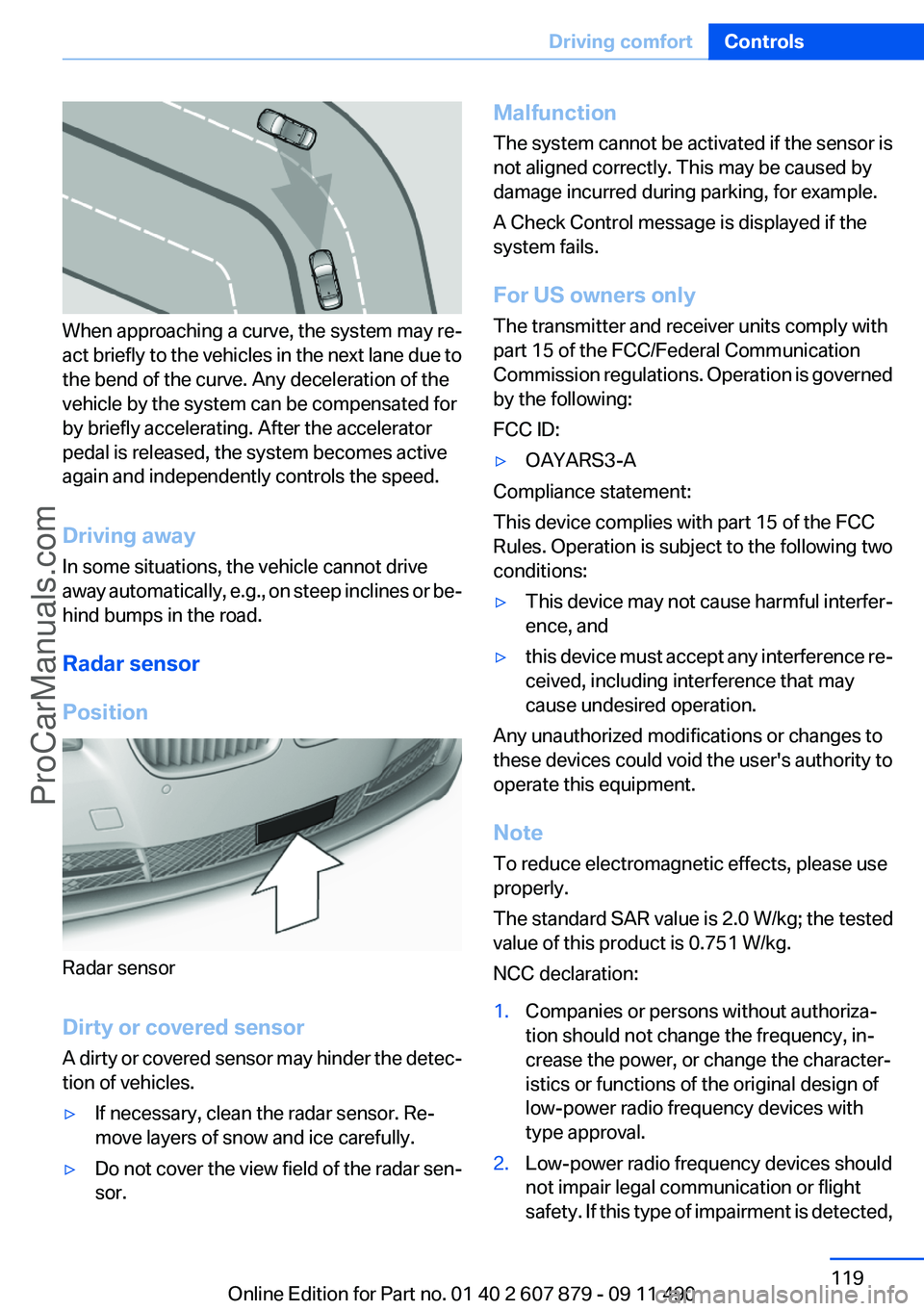
When approaching a curve, the system may re‚Äź
act briefly to the vehicles in the next lane due to
the bend of the curve. Any deceleration of the
vehicle by the system can be compensated for
by briefly accelerating. After the accelerator
pedal is released, the system becomes active
again and independently controls the speed.
Driving away
In some situations, the vehicle cannot drive
away automatically, e.g., on steep inclines or be‚Äź
hind bumps in the road.
Radar sensor
Position
Radar sensor
Dirty or covered sensor
A dirty or covered sensor may hinder the detec‚Äź
tion of vehicles.
‚Ė∑If necessary, clean the radar sensor. Re‚Äź
move layers of snow and ice carefully.‚Ė∑Do not cover the view field of the radar sen‚Äź
sor.Malfunction
The system cannot be activated if the sensor is
not aligned correctly. This may be caused by
damage incurred during parking, for example.
A Check Control message is displayed if the
system fails.
For US owners only
The transmitter and receiver units comply with
part 15 of the FCC/Federal Communication
Commission regulations. Operation is governed
by the following:
FCC ID:‚Ė∑OAYARS3-A
Compliance statement:
This device complies with part 15 of the FCC
Rules. Operation is subject to the following two
conditions:
‚Ė∑This device may not cause harmful interfer‚Äź
ence, and‚Ė∑this device must accept any interference re‚Äź
ceived, including interference that may
cause undesired operation.
Any unauthorized modifications or changes to
these devices could void the user's authority to
operate this equipment.
Note
To reduce electromagnetic effects, please use
properly.
The standard SAR value is 2.0 W/kg; the tested
value of this product is 0.751 W/kg.
NCC declaration:
1.Companies or persons without authoriza‚Äź
tion should not change the frequency, in‚Äź
crease the power, or change the character‚Äź
istics or functions of the original design of
low-power radio frequency devices with
type approval.2.Low-power radio frequency devices should
not impair legal communication or flight
safety. If this type of impairment is detected,Seite 119Driving comfortControls119
Online Edition for Part no. 01 40 2 607 879 - 09 11 490
ProCarManuals.com
Page 123 of 335

If active, the displayed speed is stored and the
vehicle reaches the stored speed if the road is
clear.‚Ė∑Each time the rocker switch is pressed to the
point of resistance, the desired speed in‚Äź
creases or decreases by approx. 1 mph/
1 km/h.‚Ė∑Each time the rocker switch is pressed past
the point of resistance, the desired speed
increases or decreases by a maximum of
5 mph/10 km/h.‚Ė∑Pressing the rocker switch to the resistance
point and holding it accelerates or deceler‚Äź
ates the vehicle without requiring pressure
on the accelerator. After the rocker switch is
released, the vehicle maintains its final
speed. Pressing the switch beyond the re‚Äź
sistance point causes the vehicle to accel‚Äź
erate more rapidly.
Resuming the desired speed
Press the button.
The stored speed is reached and maintained.
Displays in the instrument cluster
Indicator lamp Depending on how the vehicle is equip‚Äź
ped, the indicator lamp in the instrument
cluster indicates whether the system is
switched on.
Desired speed
‚Ė∑The marking lights up in
green: the system is active.‚Ė∑The marking lights up in or‚Äź
ange: the system has been
interrupted.‚Ė∑The marking does not light up: the system is
switched off.Brief status display
Selected desired speed.
If --- appears briefly on the display for Check
Control messages, it is possible that the system
requirements for operation are currently not
met.
PDC Park Distance Control
The concept
In addition to the PDC Park Distance Control, the
backup camera, refer to page 126, can be
switched on.
PDC supports you when parking. Objects that
you are approaching slowly in front of or behind
your vehicle are indicated with:‚Ė∑Signal tones.‚Ė∑Visual display.
Measurement
Measurements are made by ultrasound sensors
in the bumpers.
The range is approx. 6 ft/2 m.
An acoustic warning is first given:
‚Ė∑By the front sensors and the two rear corner
sensors at approx. 24 in/60 cm.‚Ė∑By the rear middle sensors at approx. 5 ft/
1.50 m.
System limits
Check the traffic situation as well
PDC cannot serve as a substitute for the
driver's personal judgment of the traffic situa‚Äź
tion. Check the traffic situation around the vehi‚Äź
cle with your own eyes. Otherwise, an accident
could result from road users or objects located
outside of the PDC detection range.
Seite 123Driving comfortControls123
Online Edition for Part no. 01 40 2 607 879 - 09 11 490
ProCarManuals.com
Page 124 of 335
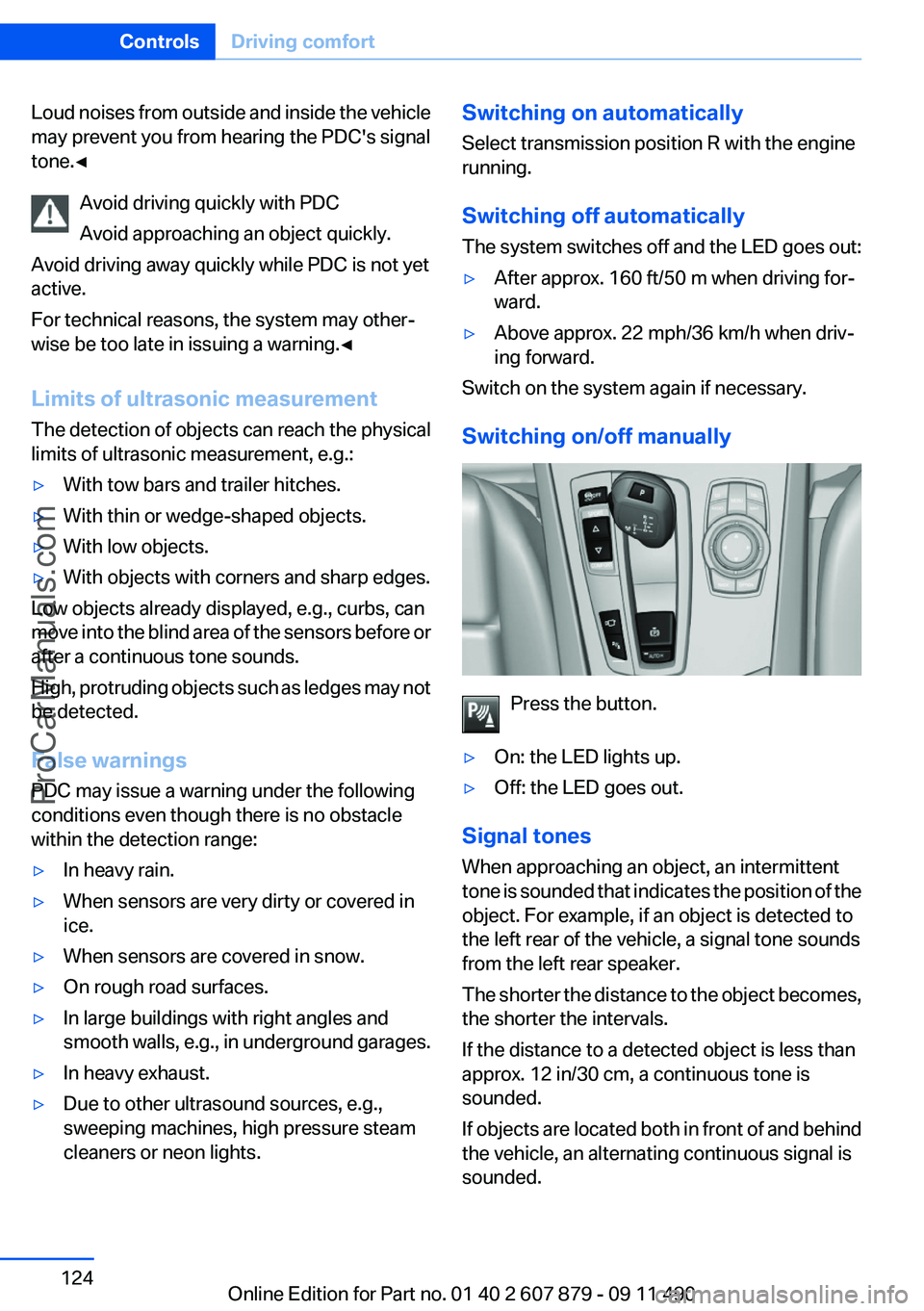
Loud noises from outside and inside the vehicle
may prevent you from hearing the PDC's signal
tone.‚óÄ
Avoid driving quickly with PDC
Avoid approaching an object quickly.
Avoid driving away quickly while PDC is not yet
active.
For technical reasons, the system may other‚Äź
wise be too late in issuing a warning.‚óÄ
Limits of ultrasonic measurement
The detection of objects can reach the physical
limits of ultrasonic measurement, e.g.:‚Ė∑With tow bars and trailer hitches.‚Ė∑With thin or wedge-shaped objects.‚Ė∑With low objects.‚Ė∑With objects with corners and sharp edges.
Low objects already displayed, e.g., curbs, can
move into the blind area of the sensors before or
after a continuous tone sounds.
High, protruding objects such as ledges may not
be detected.
False warnings
PDC may issue a warning under the following
conditions even though there is no obstacle
within the detection range:
‚Ė∑In heavy rain.‚Ė∑When sensors are very dirty or covered in
ice.‚Ė∑When sensors are covered in snow.‚Ė∑On rough road surfaces.‚Ė∑In large buildings with right angles and
smooth walls, e.g., in underground garages.‚Ė∑In heavy exhaust.‚Ė∑Due to other ultrasound sources, e.g.,
sweeping machines, high pressure steam
cleaners or neon lights.Switching on automatically
Select transmission position R with the engine
running.
Switching off automatically
The system switches off and the LED goes out:‚Ė∑After approx. 160 ft/50 m when driving for‚Äź
ward.‚Ė∑Above approx. 22 mph/36 km/h when driv‚Äź
ing forward.
Switch on the system again if necessary.
Switching on/off manually
Press the button.
‚Ė∑On: the LED lights up.‚Ė∑Off: the LED goes out.
Signal tones
When approaching an object, an intermittent
tone is sounded that indicates the position of the
object. For example, if an object is detected to
the left rear of the vehicle, a signal tone sounds
from the left rear speaker.
The shorter the distance to the object becomes,
the shorter the intervals.
If the distance to a detected object is less than
approx. 12 in/30 cm, a continuous tone is
sounded.
If objects are located both in front of and behind
the vehicle, an alternating continuous signal is
sounded.
Seite 124ControlsDriving comfort124
Online Edition for Part no. 01 40 2 607 879 - 09 11 490
ProCarManuals.com
Page 125 of 335
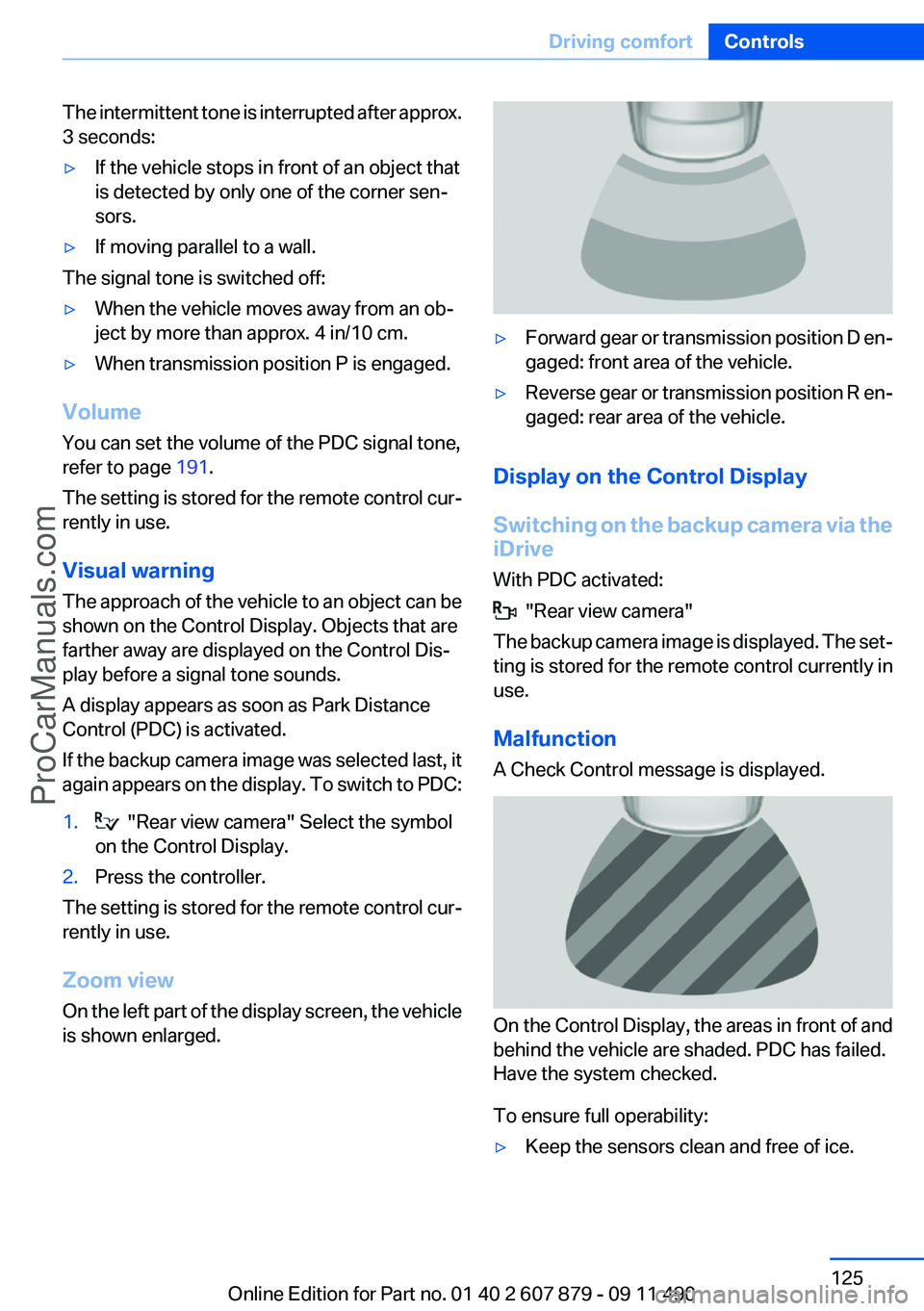
The intermittent tone is interrupted after approx.
3 seconds:‚Ė∑If the vehicle stops in front of an object that
is detected by only one of the corner sen‚Äź
sors.‚Ė∑If moving parallel to a wall.
The signal tone is switched off:
‚Ė∑When the vehicle moves away from an ob‚Äź
ject by more than approx. 4 in/10 cm.‚Ė∑When transmission position P is engaged.
Volume
You can set the volume of the PDC signal tone,
refer to page 191.
The setting is stored for the remote control cur‚Äź
rently in use.
Visual warning
The approach of the vehicle to an object can be
shown on the Control Display. Objects that are
farther away are displayed on the Control Dis‚Äź
play before a signal tone sounds.
A display appears as soon as Park Distance
Control (PDC) is activated.
If the backup camera image was selected last, it
again appears on the display. To switch to PDC:
1. "Rear view camera" Select the symbol
on the Control Display.2.Press the controller.
The setting is stored for the remote control cur‚Äź
rently in use.
Zoom view
On the left part of the display screen, the vehicle
is shown enlarged.
‚Ė∑Forward gear or transmission position D en‚Äź
gaged: front area of the vehicle.‚Ė∑Reverse gear or transmission position R en‚Äź
gaged: rear area of the vehicle.
Display on the Control Display
Switching on the backup camera via the
iDrive
With PDC activated:
"Rear view camera"
The backup camera image is displayed. The set‚Äź
ting is stored for the remote control currently in
use.
Malfunction
A Check Control message is displayed.
On the Control Display, the areas in front of and
behind the vehicle are shaded. PDC has failed.
Have the system checked.
To ensure full operability:
‚Ė∑Keep the sensors clean and free of ice.Seite 125Driving comfortControls125
Online Edition for Part no. 01 40 2 607 879 - 09 11 490
ProCarManuals.com
Page 126 of 335
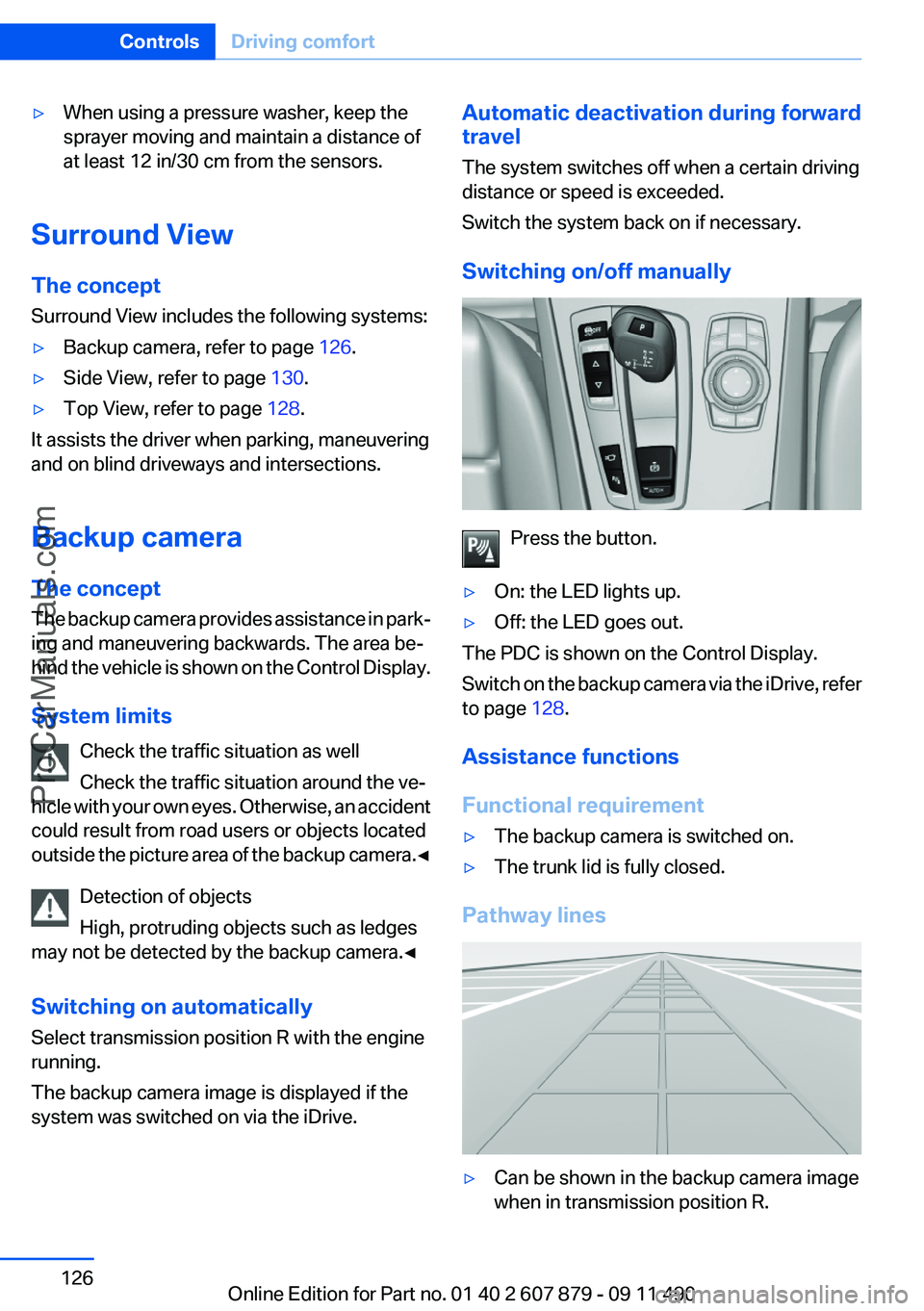
‚Ė∑When using a pressure washer, keep the
sprayer moving and maintain a distance of
at least 12 in/30 cm from the sensors.
Surround View
The concept
Surround View includes the following systems:
‚Ė∑Backup camera, refer to page 126.‚Ė∑Side View, refer to page 130.‚Ė∑Top View, refer to page 128.
It assists the driver when parking, maneuvering
and on blind driveways and intersections.
Backup camera
The concept
The backup camera provides assistance in park‚Äź
ing and maneuvering backwards. The area be‚Äź
hind the vehicle is shown on the Control Display.
System limits Check the traffic situation as well
Check the traffic situation around the ve‚Äź
hicle with your own eyes. Otherwise, an accident
could result from road users or objects located
outside the picture area of the backup camera. ‚óÄ
Detection of objects
High, protruding objects such as ledges
may not be detected by the backup camera.‚óÄ
Switching on automatically
Select transmission position R with the engine
running.
The backup camera image is displayed if the
system was switched on via the iDrive.
Automatic deactivation during forward
travel
The system switches off when a certain driving
distance or speed is exceeded.
Switch the system back on if necessary.
Switching on/off manually
Press the button.
‚Ė∑On: the LED lights up.‚Ė∑Off: the LED goes out.
The PDC is shown on the Control Display.
Switch on the backup camera via the iDrive, refer
to page 128.
Assistance functions
Functional requirement
‚Ė∑The backup camera is switched on.‚Ė∑The trunk lid is fully closed.
Pathway lines
‚Ė∑Can be shown in the backup camera image
when in transmission position R.Seite 126ControlsDriving comfort126
Online Edition for Part no. 01 40 2 607 879 - 09 11 490
ProCarManuals.com
Page 131 of 335

Contrast
With the Side View switched on:1. "Contrast"2.Turn the controller until the desired setting
is reached and press the controller.
Cameras
The two camera lenses are located on the sides
of the bumper.
The image quality may be impaired by dirt.
Clean the lens, refer to page 307.
Parking assistant
The concept
This system assists the driver in parking parallel
to the road.
Ultrasound sensors measure parking spaces on
both sides of the vehicle.
The parking assistant calculates the best pos‚Äź
sible parking line and takes control of steering
during the parking procedure.
When parking, also take note of the visual and
acoustic information issued by the PDC and the
parking assistant and accelerate or brake ac‚Äź
cordingly.
A component of the parking assistant is the PDC
Park Distance Control, refer to page 123.
Personal responsibility
The parking assistant does not relieve the
driver of responsibility for the vehicle during the
parking procedure.
Watch the parking space and parking procedure
closely and intervene if necessary; otherwise,
there is the danger of an accident.‚óÄ
Requirements
For measuring parking spaces‚Ė∑Maximum speed while driving forward ap‚Äź
prox. 22 mph/35 km/h.‚Ė∑Maximum distance to row of parked vehi‚Äź
cles: 5 ft/1.5 m.
Suitable parking space
‚Ė∑Gap between two objects with a minimum
length of approx. 5 ft/1.5 m.‚Ė∑Minimum length: own vehicle length plus
approx. 4 ft/1.2 m.‚Ė∑Minimum depth: approx. 5 ft/1.5 m.
For parking procedure
Closed doors.
Seite 131Driving comfortControls131
Online Edition for Part no. 01 40 2 607 879 - 09 11 490
ProCarManuals.com
Page 134 of 335

Therefore, always be alert and ready to inter‚Äź
vene; otherwise, there is the danger of an acci‚Äź
dent occurring.‚óÄ
Curbs
The parking assistant may steer the vehi‚Äź
cle over or onto curbs.
Therefore, always be alert and ready to inter‚Äź
vene; otherwise, the wheels, tires, or the vehicle
may become damaged.‚óÄ
No parking assistance
The parking assistant does not provide assis‚Äź
tance in parking.‚Ė∑In tight curves.
Functional limitations
The system may not be fully functional in the
following situations:
‚Ė∑When sensors are dirty or iced over.‚Ė∑In heavy fog, rain or snowfall.‚Ė∑On bumpy road surfaces such as gravel
roads.‚Ė∑When leaves or snow has collected in the
parking space.
Limits of ultrasonic measurement
The detection of objects can reach the physical
limits of ultrasonic measurement, e.g.:
‚Ė∑With tow bars and trailer hitches.‚Ė∑With thin or wedge-shaped objects.‚Ė∑With elevated, protruding objects such as
ledges or cargo.‚Ė∑With objects with corners and sharp edges.‚Ė∑With objects with a fine surface structure,
such as fences.
The parking assistant may identify parking
spaces that are not suitable for parking.
Ultrasound sensors
The ultrasounds sensors used to measure park‚Äź
ing spaces are located in the side turn signals.
To ensure full operability:
‚Ė∑Keep the sensors clean and free of ice.‚Ė∑When using high-pressure washers, do not
spray the sensors for long periods and main‚Äź
tain a distance of at least 12 in/30 cm.
Night Vision with pedestrian
detection
The concept
Night Vision with pedestrian detection is a night
vision system.
An infrared camera records the area in front of
the vehicle and displays the image on the Con‚Äź
trol Display.
The picture is a heat image. The system has an
integrated pedestrian detection function that
detects pedestrians and cyclists. Warm objects
that are similar in shape to human beings are
detected by the system.
Personal responsibility
Night Vision cannot replace the driver's
personal judgment of the visibility conditions
and the traffic situation. The view ahead and the
actual visibility conditions must always be the
basis on which the vehicle speed is adjusted;
otherwise, there is a risk to road safety.‚óÄ
Seite 134ControlsDriving comfort134
Online Edition for Part no. 01 40 2 607 879 - 09 11 490
ProCarManuals.com
Page 140 of 335
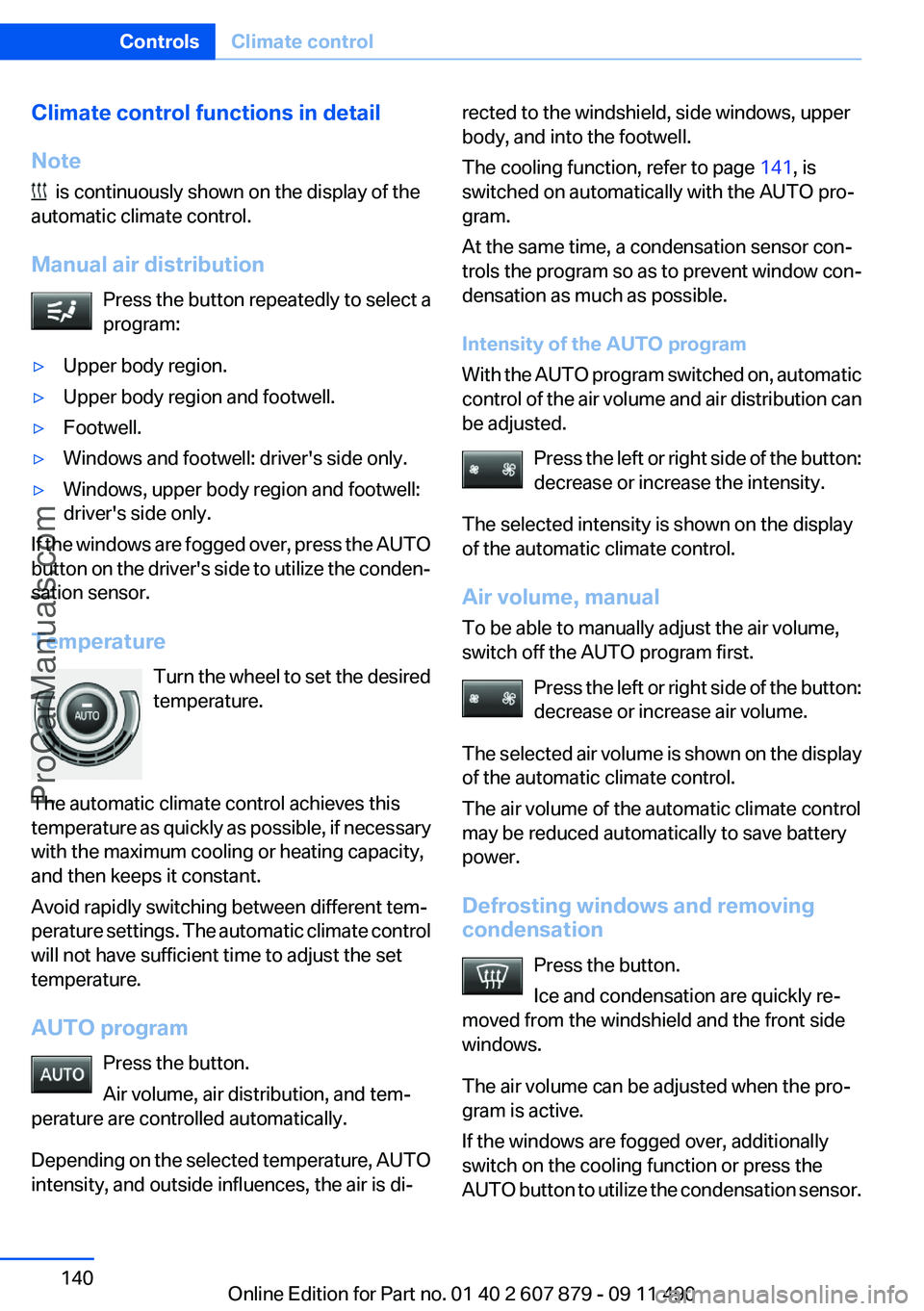
Climate control functions in detail
Note
is continuously shown on the display of the
automatic climate control.
Manual air distribution Press the button repeatedly to select a
program:
‚Ė∑Upper body region.‚Ė∑Upper body region and footwell.‚Ė∑Footwell.‚Ė∑Windows and footwell: driver's side only.‚Ė∑Windows, upper body region and footwell:
driver's side only.
If the windows are fogged over, press the AUTO
button on the driver's side to utilize the conden‚Äź
sation sensor.
Temperature Turn the wheel to set the desired
temperature.
The automatic climate control achieves this
temperature as quickly as possible, if necessary
with the maximum cooling or heating capacity,
and then keeps it constant.
Avoid rapidly switching between different tem‚Äź
perature settings. The automatic climate control
will not have sufficient time to adjust the set
temperature.
AUTO program Press the button.
Air volume, air distribution, and tem‚Äź
perature are controlled automatically.
Depending on the selected temperature, AUTO
intensity, and outside influences, the air is di‚Äź
rected to the windshield, side windows, upper
body, and into the footwell.
The cooling function, refer to page 141, is
switched on automatically with the AUTO pro‚Äź
gram.
At the same time, a condensation sensor con‚Äź
trols the program so as to prevent window con‚Äź
densation as much as possible.
Intensity of the AUTO program
With the AUTO program switched on, automatic
control of the air volume and air distribution can
be adjusted.
Press the left or right side of the button:
decrease or increase the intensity.
The selected intensity is shown on the display
of the automatic climate control.
Air volume, manual
To be able to manually adjust the air volume,
switch off the AUTO program first.
Press the left or right side of the button:
decrease or increase air volume.
The selected air volume is shown on the display
of the automatic climate control.
The air volume of the automatic climate control
may be reduced automatically to save battery
power.
Defrosting windows and removing
condensation
Press the button.
Ice and condensation are quickly re‚Äź
moved from the windshield and the front side
windows.
The air volume can be adjusted when the pro‚Äź
gram is active.
If the windows are fogged over, additionally
switch on the cooling function or press the
AUTO button to utilize the condensation sensor.Seite 140ControlsClimate control140
Online Edition for Part no. 01 40 2 607 879 - 09 11 490
ProCarManuals.com
Page 141 of 335
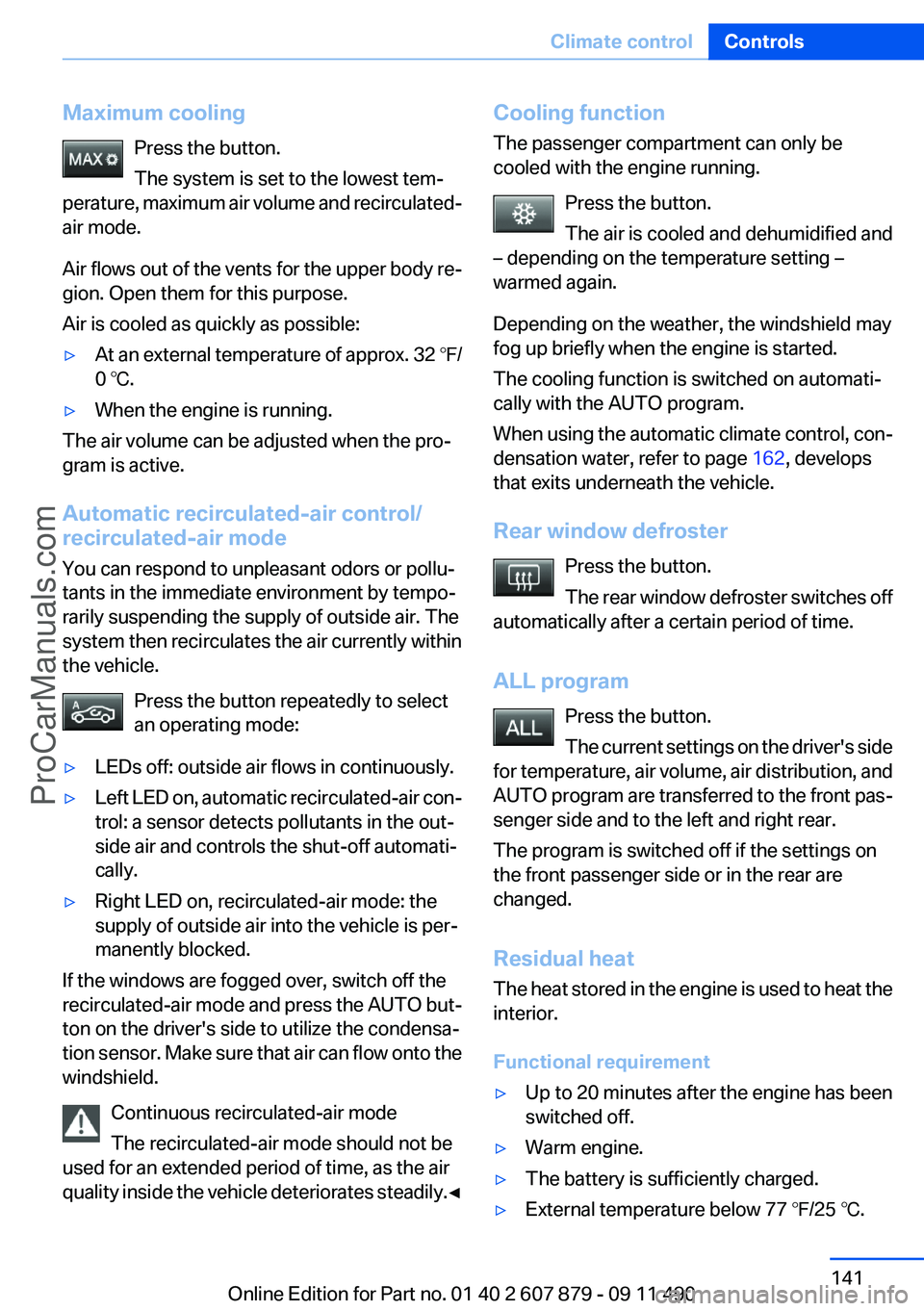
Maximum coolingPress the button.
The system is set to the lowest tem‚Äź
perature, maximum air volume and recirculated-
air mode.
Air flows out of the vents for the upper body re‚Äź
gion. Open them for this purpose.
Air is cooled as quickly as possible:‚Ė∑At an external temperature of approx. 32 ‚ĄČ/
0 ‚ĄÉ.‚Ė∑When the engine is running.
The air volume can be adjusted when the pro‚Äź
gram is active.
Automatic recirculated-air control/
recirculated-air mode
You can respond to unpleasant odors or pollu‚Äź
tants in the immediate environment by tempo‚Äź
rarily suspending the supply of outside air. The
system then recirculates the air currently within
the vehicle.
Press the button repeatedly to select
an operating mode:
‚Ė∑LEDs off: outside air flows in continuously.‚Ė∑Left LED on, automatic recirculated-air con‚Äź
trol: a sensor detects pollutants in the out‚Äź
side air and controls the shut-off automati‚Äź
cally.‚Ė∑Right LED on, recirculated-air mode: the
supply of outside air into the vehicle is per‚Äź
manently blocked.
If the windows are fogged over, switch off the
recirculated-air mode and press the AUTO but‚Äź
ton on the driver's side to utilize the condensa‚Äź
tion sensor. Make sure that air can flow onto the
windshield.
Continuous recirculated-air mode
The recirculated-air mode should not be
used for an extended period of time, as the air
quality inside the vehicle deteriorates steadily. ‚óÄ
Cooling function
The passenger compartment can only be
cooled with the engine running.
Press the button.
The air is cooled and dehumidified and
‚Äď depending on the temperature setting ‚Äď
warmed again.
Depending on the weather, the windshield may
fog up briefly when the engine is started.
The cooling function is switched on automati‚Äź
cally with the AUTO program.
When using the automatic climate control, con‚Äź
densation water, refer to page 162, develops
that exits underneath the vehicle.
Rear window defroster Press the button.
The rear window defroster switches off
automatically after a certain period of time.
ALL program Press the button.
The current settings on the driver's side
for temperature, air volume, air distribution, and
AUTO program are transferred to the front pas‚Äź
senger side and to the left and right rear.
The program is switched off if the settings on
the front passenger side or in the rear are
changed.
Residual heat
The heat stored in the engine is used to heat the
interior.
Functional requirement‚Ė∑Up to 20 minutes after the engine has been
switched off.‚Ė∑Warm engine.‚Ė∑The battery is sufficiently charged.‚Ė∑External temperature below 77 ‚ĄČ/25 ‚ĄÉ.Seite 141Climate controlControls141
Online Edition for Part no. 01 40 2 607 879 - 09 11 490
ProCarManuals.com
Page 172 of 335
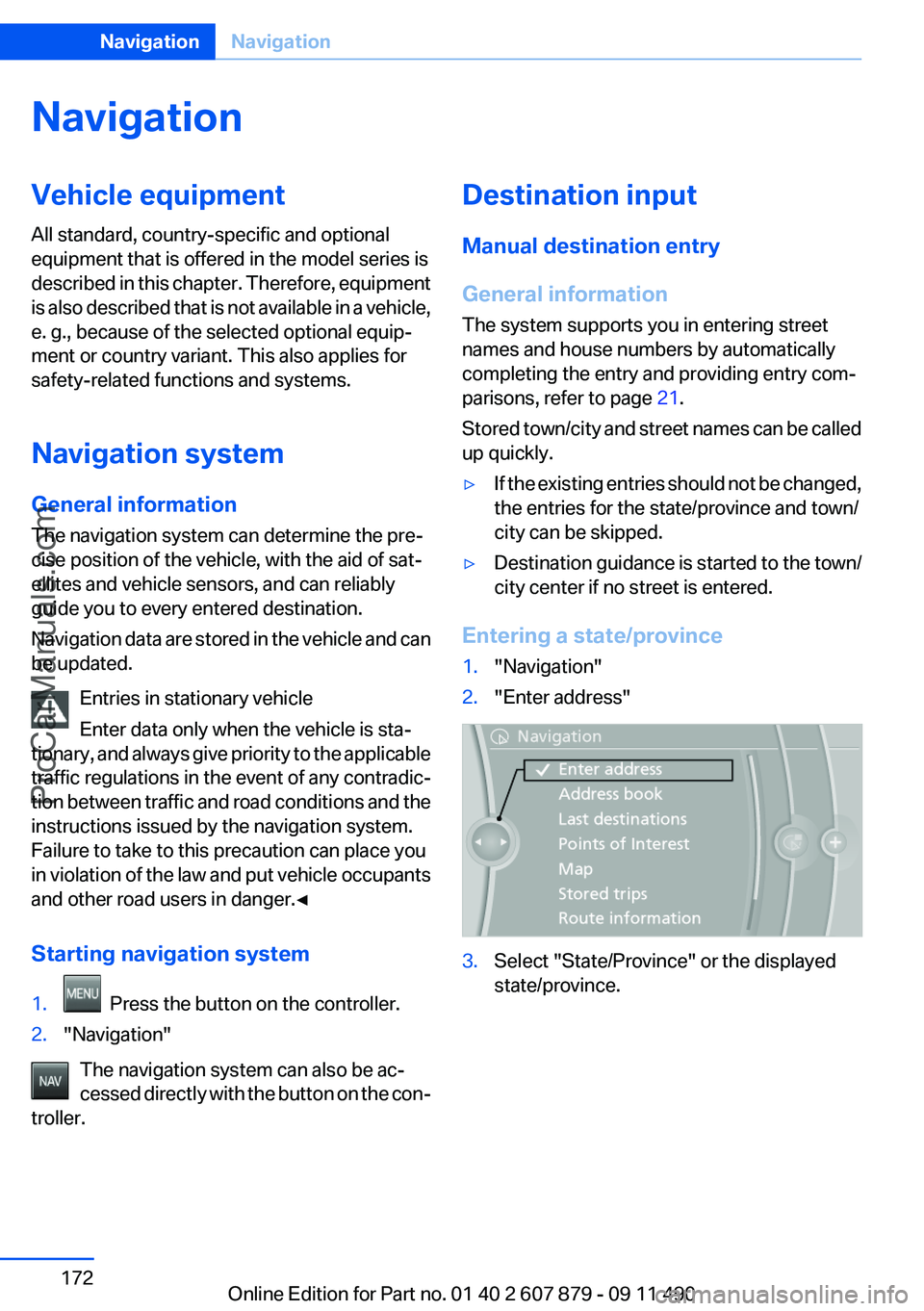
NavigationVehicle equipment
All standard, country-specific and optional
equipment that is offered in the model series is
described in this chapter. Therefore, equipment
is also described that is not available in a vehicle,
e. g., because of the selected optional equip‚Äź
ment or country variant. This also applies for
safety-related functions and systems.
Navigation system
General information
The navigation system can determine the pre‚Äź
cise position of the vehicle, with the aid of sat‚Äź
ellites and vehicle sensors, and can reliably
guide you to every entered destination.
Navigation data are stored in the vehicle and can
be updated.
Entries in stationary vehicle
Enter data only when the vehicle is sta‚Äź
tionary, and always give priority to the applicable
traffic regulations in the event of any contradic‚Äź
tion between traffic and road conditions and the
instructions issued by the navigation system.
Failure to take to this precaution can place you
in violation of the law and put vehicle occupants
and other road users in danger.‚óÄ
Starting navigation system1. Press the button on the controller.2."Navigation"
The navigation system can also be ac‚Äź
cessed directly with the button on the con‚Äź
troller.
Destination input
Manual destination entry
General information
The system supports you in entering street
names and house numbers by automatically
completing the entry and providing entry com‚Äź
parisons, refer to page 21.
Stored town/city and street names can be called
up quickly.‚Ė∑If the existing entries should not be changed,
the entries for the state/province and town/
city can be skipped.‚Ė∑Destination guidance is started to the town/
city center if no street is entered.
Entering a state/province
1."Navigation"2."Enter address"3.Select "State/Province" or the displayed
state/province.Seite 172NavigationNavigation172
Online Edition for Part no. 01 40 2 607 879 - 09 11 490
ProCarManuals.com